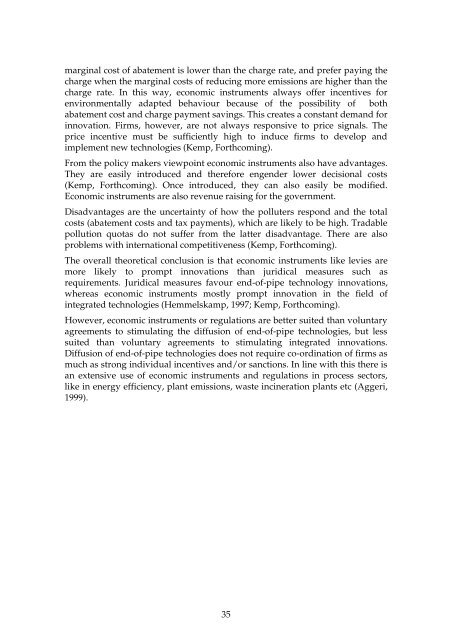Drivers of environmental innovation - Vinnova
Drivers of environmental innovation - Vinnova
Drivers of environmental innovation - Vinnova
Create successful ePaper yourself
Turn your PDF publications into a flip-book with our unique Google optimized e-Paper software.
marginal cost <strong>of</strong> abatement is lower than the charge rate, and prefer paying the<br />
charge when the marginal costs <strong>of</strong> reducing more emissions are higher than the<br />
charge rate. In this way, economic instruments always <strong>of</strong>fer incentives for<br />
<strong>environmental</strong>ly adapted behaviour because <strong>of</strong> the possibility <strong>of</strong> both<br />
abatement cost and charge payment savings. This creates a constant demand for<br />
<strong>innovation</strong>. Firms, however, are not always responsive to price signals. The<br />
price incentive must be sufficiently high to induce firms to develop and<br />
implement new technologies (Kemp, Forthcoming).<br />
From the policy makers viewpoint economic instruments also have advantages.<br />
They are easily introduced and therefore engender lower decisional costs<br />
(Kemp, Forthcoming). Once introduced, they can also easily be modified.<br />
Economic instruments are also revenue raising for the government.<br />
Disadvantages are the uncertainty <strong>of</strong> how the polluters respond and the total<br />
costs (abatement costs and tax payments), which are likely to be high. Tradable<br />
pollution quotas do not suffer from the latter disadvantage. There are also<br />
problems with international competitiveness (Kemp, Forthcoming).<br />
The overall theoretical conclusion is that economic instruments like levies are<br />
more likely to prompt <strong>innovation</strong>s than juridical measures such as<br />
requirements. Juridical measures favour end-<strong>of</strong>-pipe technology <strong>innovation</strong>s,<br />
whereas economic instruments mostly prompt <strong>innovation</strong> in the field <strong>of</strong><br />
integrated technologies (Hemmelskamp, 1997; Kemp, Forthcoming).<br />
However, economic instruments or regulations are better suited than voluntary<br />
agreements to stimulating the diffusion <strong>of</strong> end-<strong>of</strong>-pipe technologies, but less<br />
suited than voluntary agreements to stimulating integrated <strong>innovation</strong>s.<br />
Diffusion <strong>of</strong> end-<strong>of</strong>-pipe technologies does not require co-ordination <strong>of</strong> firms as<br />
much as strong individual incentives and/or sanctions. In line with this there is<br />
an extensive use <strong>of</strong> economic instruments and regulations in process sectors,<br />
like in energy efficiency, plant emissions, waste incineration plants etc (Aggeri,<br />
1999).<br />
35

















